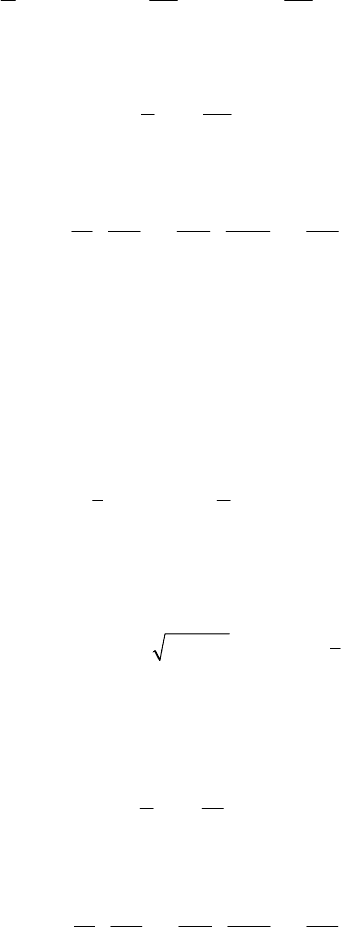Teodorescu P.P. Mechanical Systems, Volume III: Analytical Mechanics
Подождите немного. Документ загружается.


Variational Principles. Canonical Transformations
261
and with the displacement acceleration
2
2
t
t
∂∂
=== =
∂
∂
vu
av u
.
(20.1.90'')
In this case, the kinetic energy density will be given by
1
2
ii
uuμ= T ,
(20.1.91)
where
(;)tμμ= r is the density.
The work effected by the external given forces is stored by the elastic solid and
given back by unloading and bringing to the initial form as a work of internal forces (or
internal work); it is called also deformation work or strain energy. We denote by w the
unit deformation work (the deformation work density or the elastic potential), that is the
work corresponding to the unit volume in the vicinity of a point of the body, and which
the state of stress (the totality of stresses around a point) yields by the state of strain (the
totality of strains around a point) of the solid at the very same point. We call elementary
deformation work (elementary strain energy) the work corresponding to a volume
element
dΩ of the domain Ω occupied by the solid; we have
int
ddWwΩ= . (20.1.92)
The internal work is then given by
int
dWw
Ω
Ω=
∫
,
(20.1.92')
where
1
2
ij ij
w σε=
(20.1.93)
is the elastic potential. We have introduced the stress tensor
ij
σ , ,1,2,3ij= (if ij=
we obtain the normal stresses, while if
ij≠ we obtain the tangential stresses). If we
take into account the linear constitutive law of R. Hooke
()
1
2
ij ij ij
ll
σλεδ ε
ν
⎡⎤
=−−
⎢⎥
⎣⎦
, ,1,2,3ij= ,
(20.1.94)
in case of a homogeneous, isotropic body, where λ is Lamé’s elastic constant and ν is
the transverse contraction coefficient of Poisson (Poisson’s ratio), we may write also
()
2
11
() 2
2
ij ij
ll
w λε εε
ν
⎡
⎤
=−−
⎢
⎥
⎣
⎦
.
(20.1.93')

MECHANICAL SYSTEMS, CLASSICAL MODELS
262
Finally, the potential energy density is given by
w=−⋅V Fu
,
(20.1.95)
where
F is the volumic force (the external given force on the unit volume).
We find thus the kinetic potential density of Lagrange
()
2
,,,,,
11 11
() 1 ( )( )
22 22
j j jj ij ji ij ji
uu u u u u uμλ
ν
⎡⎤
=− −− + ++⋅
⎢⎥
⎣⎦
L Fu;
(20.1.96)
Euler–Ostrogradskiĭ equations will be of the form (we remind observations in Sect.
20.1.1.3)
,
dd
0
dd
jijij
tu x u u
∂∂∂
⎛⎞ ⎛ ⎞
+−=
⎜⎟ ⎜ ⎟
∂∂∂
⎝⎠ ⎝ ⎠
LLL
, 1, 2, 3j = .
(20.1.96')
Finally,
()
,,,
,
1
() 1 ( ) 0
2
jijjiij
llj
uu uu F
t
μλ
ν
∂
⎡⎤
−−− + +=
⎢⎥
∂
⎣⎦
, 1, 2, 3
j
= ,
so that
,
2
(1 2 ) ( ) 0
jiij j j
uu F u
t
ν
νμ
λ
∂
⎡⎤
−Δ+ + − =
⎢⎥
∂
⎣⎦
, 1, 2, 3j = .
(20.1.97)
We obtain thus the equations of motion of the homogeneous, isotropic linear elastic
solid, subjected to infinitesimal deformations; these equations, expressed in
displacements, are G. Lamé’s equations. If
constμ = , we can write
[]
,
2
(1 2 ) 0
jiij j j
uu F u
ν
νμ
λ
−Δ+ + − = , 1, 2, 3j = .
(20.1.97')
In vectorial form, we have
2
(1 2 ) grad div ( )
ν
ν
λ
−Δ+ + −=
uuFu0,
(20.1.97'')
where the unknown function is the displacement vector
(;)t=uur.
20.1.5.4 Motion of Strings
Let be a string of length l, extended along the axis
3
Ox by a static tension
0
T ,
without any external given force; in this case, the kinetic energy is given by
22
33 33
00
1
dd
22
ll
Tux ux
μ
μ
==
∫∫
,
(20.1.98)

Variational Principles. Canonical Transformations
263
where
constμ = is the linear density of the string (see Sect. 12.2.1.3).
The potential energy is written in the form (we assume that both states of stress and
strain are one-dimensional)
22
33 33 3 33 3 3,3 3
000
dd d
222
lll
AEAEA
Vxxux
σε ε===
∫∫∫
.
(20.1.98')
In this case,
22
33,3
22
EA
uu
μ
=−L .
(20.1.98'')
The Euler–Ostrogradskiĭ equation
333,33
dd
0
ddtu x u u
∂∂∂
⎛⎞
⎛⎞
+−=
⎜⎟
⎜⎟
∂∂∂
⎝⎠
⎝⎠
LLL
leads to the equation of longitudinal proper vibration of strings
3,33 3
0EAu uμ−= ,
(20.1.99)
corresponding to the equations (12.2.20') and (20.1.75').
In case of displacements normal to the axis, let be this one along the
1
Ox –axis, the
kinetic energy is given by
22
13 13
00
1
dd
22
ll
Tux ux
μ
μ
==
∫∫
,
(20.1.100)
the linear density being constant. The potential energy is calculated in the form (ds is
along the deformed form of the string; see also Fig. 12.8)
22
00 0
31,331,33
00 0
1
(d d ) ( 1 1)d d
2
ll l
VTsxT u xTux=−=+−=
∫∫ ∫
,
(20.1.100')
where we have expanded the integrand into a series after Newton’s binomial and we
have neglected terms of superior order (corresponding to the linearization hypothesis).
We obtain
0
22
11,3
22
T
uu
μ
=−L .
(20.1.100'')
The Euler–Ostrogradskiĭ equation
131,31
dd
0
ddtu x u u
∂∂∂
⎛⎞
⎛⎞
+−=
⎜⎟
⎜⎟
∂∂∂
⎝⎠
⎝⎠
LLL

MECHANICAL SYSTEMS, CLASSICAL MODELS
264
leads to
0
11,33
0uTuμ −= ,
(20.1.101)
hence to the equation of proper transverse vibrations of strings, corresponding to the
equations (12.2.22').
20.1.5.5 Motion of Bars
In case of a straight bar one must take into account the transverse contraction, so that
the transverse displacements of the bar
3
Ox –axis will be
113,3
uxuν=− ,
223,3
uxuν=− , the corresponding displacement velocities being given by
113,3
uxuν=−,
223,3
uxuν=−. We obtain the kinetic energy
()()
222 2222
123 3 3,33
0
1
dd
22
l
O
Tuuu uiux
A
Ω
μμ
Ων
=++=+
∫∫
,
(20.1.102)
where
O
i is the gyration radius of the cross section with respect to the pole O, given by
()
222
12
d
O
A
Ai x x A=+
∫∫
,
(20.1.102')
while
μ is the linear density, constant on the cross section. The potential energy is given
by a formula of the form (20.1.98'), so that
()
2222 2
33,3 3,3
1
22
O
uiu EAu
μ
ν
=+ −L .
(20.1.102'')
The Euler–Ostrogradskiĭ equation (in the form of the equation (7.2.11'))
2
33,3 3 33,3 3
ddd
0
dd d d
xt u t u x u u
∂∂ ∂∂
⎛⎞ ⎛⎞
⎛⎞
−− +=
⎜⎟
⎜⎟ ⎜⎟
∂∂∂∂
⎝⎠
⎝⎠ ⎝⎠
LL LL
leads to the A.E.H. Love’s equation
()
22
3,33 3 3,33
0
O
EAu u i uμν−− = .
(20.1.103)
Neglecting the term which multiplies
2
ν , we find the longitudinal proper vibrations
equation of the straight bars in the classical form (20.1.99), in fact the equation
(12.2.42).
In case of the transverse vibrations of the straight bar, the kinetic energy due to the
motion of translation and to the rotation of the cross section is
2
2
13 2 1,3 3
00
11
d()d
22
ll
TuxIux
At
μ
μ
∂
⎡⎤
=+
⎢⎥
∂
⎣⎦
∫∫
222
13 2 1,33
00
11
dd
22
ll
ux i u xμμ=+
∫∫
,
(20.1.104)

Variational Principles. Canonical Transformations
265
where
2
I is the moment of inertia with respect to the neutral axis of the bar (
2
Ox -axis),
2
i being the corresponding gyration radius. Observing that
33 1 1,33
xuε =− ,
33 33
Eσε= , we can write
22 2
1,33 3 1 1 2 2 1,33
0
11
ddd
22
l
A
VEuxxxx EIu==
∫∫
,
(20.1.104')
so that
()
222 2
1 2 1,3 2 1,33
11
22
uiu EIuμ=+−L .
(20.1.104'')
As in the preceding case, the Euler–Ostrogradskiĭ equation
22
2
3 1,3 1,33 1 3 1,3 1
3
dddd
0
dd d d
d
xt u u t u x u u
x
∂∂∂∂∂
⎛⎞ ⎛ ⎞ ⎛⎞
⎛⎞
+−−+=
⎜⎟
⎜⎟ ⎜ ⎟ ⎜⎟
∂∂∂∂∂
⎝⎠
⎝⎠ ⎝ ⎠ ⎝⎠
LLLLL
leads to the proper transverse vibrations equation of the straight bar in the form
()
2
2 1,3333 1 2 1,33
0EI u u i uμ+− = ,
(20.1.105)
corresponding to the equation (12.2.47).
20.2 Canonical Transformations
In general, applying directly the Hamiltonian formalism (instead of the Lagrangian
one), the difficulty to solve a problem of mechanics does not diminish sensibly; the
differential equations are practically equivalent. The advantage of using a Hamiltonian
formalism consists – particularly – in a profound understanding of the formal structure
of mechanics; there appears a greater liberty to choose canonical co-ordinates
(generalized co-ordinates and momenta). The corresponding formulations, just because
of their abstraction, allow to elaborate new theories concerning matter, nature,
Universe; they constitute a starting point for quantum as well as for statistical
mechanics.
In Sect. 18.2.3.1 we have seen that point transformations let invariant Lagrange’s
equations; a study of the transformations which let invariant Hamilton’s equations is
thus necessary, so that the use of the Hamiltonian formalism is once more justified.
20.2.1 General Considerations. Conditions of Canonicity
In what follows, canonical transformations are introduced; especially, accent is put
on the statement of canonicity conditions. We mention also various applications,
including those in the perturbation theory. A particular attention is given to
infinitesimal canonical transformations.

MECHANICAL SYSTEMS, CLASSICAL MODELS
266
20.2.1.1 Preliminary Considerations. Examples
Let be a transformation of canonical variables of the form
()
,;
jj
QQqpt= ,
()
,;
jj
PPqpt= , 1,2,...,
j
s= , (20.2.1)
where
j
Q and
j
P are functions of class
2
C , having the Jacobian
()
()
,
det 0
,
QP
J
qp
∂
∂
⎡⎤
=≠
⎢⎥
⎣⎦
,
(20.2.1')
with
{
}
12
, ,...,
s
QQQ Q≡ ,
{
}
12
, ,...,
s
PPP P≡ ,
{
}
12
, ,...,
s
qqq q≡ ,
{
12
,,ppp≡
}
...,
s
p ; the time
t
plays the rôle of a parameter in this transformation.
Hamilton’s function becomes
()
,;Hqpt =
()(
,;,HqQPt
())
,; ;pQPt t
()
,;HQPt= . The transformation (20.2.1), (20.2.1') is called canonical
transformation if Hamilton’s canonical system (19.1.14) keeps its form, hence if
j
H
Q
P
∂
∂
=
,
j
j
H
P
Q
∂
∂
=−
,
1,2,...,
j
s=
.
(20.2.2)
The theorem of implicit functions and the condition (20.2.1') ensure the existence of
the inverse transformation
()
,;
kk
qqQPt=
,
()
,;
kk
ppQPt=
, 1,2,...,ks= , (20.2.1'')
these functions being also of class
2
C . The canonical co-ordinates ,qp and ,QP
correspond to the same representative point in the space
2s
Γ .
The transformations (20.2.1), (20.2.1'), and (20.2.1'') are called complete canonical
transformations if they do not depend explicitly on time. Together with A. Sommerfeld,
these transformations are called contact transformations too (Sommerfeld, A., 1962).
Other authors give this denomination to the transformations (20.2.1) to which we add
the function
()
,;TTqpt= , (20.2.3)
of the same class
2
C (hence, for which t is no more a parameter), so that
()
()
,;
det 0
,;
QPT
qpt
∂
∂
⎡⎤
≠
⎢⎥
⎣⎦
.
(20.2.3')
But it is not necessary to consider such transformations in the following study; they can
be useful in a relativistic modelling of mechanical phenomena.
Starting from canonical equations of a complicated form, we can obtain simpler
equations of motion by means of canonical transformations; practically, the
Hamiltonian
H can have a simpler structure than Hamilton’s function H . In particular,

Variational Principles. Canonical Transformations
267
if we find the canonical transformation for which
constH = (independent of Q and
P ) along the trajectory of the representative point, then the solution of the canonical
system (20.2.2) will be
j
j
QA= ,
j
j
PB= , 1,2,...,js= ,
(20.2.4)
where
j
A and
j
B are constants; the functions (20.2.1) are, in this case, first integrals
of the canonical system (19.1.14).
Let be the transformation
j
j
Qqα= ,
j
j
Ppδ= , 1,2,...,
j
s= ,
(20.2.5)
where
α and δ are non-vanishing constants; the equations (20.2.2) are easily verified,
together with the equations (19.1.14), in case of the new Hamiltonian
HHαδ= .
(20.2.5')
Hence, this transformation is a complete canonical transformation.
As well, the transformation
j
j
Qpβ= ,
j
j
Pqγ= , 1,2,...,js= , (20.2.6)
where
β and γ are non-zero constants, and for which
HHβγ=− ,
(20.2.6')
is also a complete canonical transformation.
Analogically, we can show that the transformation
tan
jj
Qp t= , cot
jj
Pq t= ,
1,2,...,
j
s=
, (20.2.7)
with
2
sin2
j
j
HH QP
t
=− + ,
(20.2.7')
is a canonical one. The direct proof of this affirmation is rather complicated. For
instance, we have
2
1
tan
cos
jjj
Qppt
t
=+
,
2
21
tan
sin2
cos
j
j
jj j
HH H
Qtp
PP t Q
t
∂∂ ∂
∂∂ ∂
=− + =− + ;
taking into account (19.1.14), the first equation (20.2.2) is verified.
As well, it is not completely clear how one can obtain such transformations. For this
goal, we will give – in what follows – various conditions of canonicity and will put in
evidence the possibility to construct canonical transformations.

MECHANICAL SYSTEMS, CLASSICAL MODELS
268
20.2.1.2 Complete Canonical Transformations
Let be a complete canonical transformation
(, )
jj
QQqp= , (, )
jj
PPqp= , 1,2,..,
j
s= ,
(20.2.8)
where
j
Q ,
j
P are functions of class
2
C which verify the condition (20.2.1'). We
consider the differential form of the first degree (the one-form)
dd
j
j
kk
pq PQψ =−. (20.2.9)
The canonical form (20.1.41) of Hamilton’s principle leads to
()
[]
()
[]
11
00
d,;d ,;d
tt
jj
kk
tt
pq Hqpt t PdQ HQPt tδδ−=−
∫∫
.
To obtain the canonical equations (20.2.2), corresponding to Livens’s Theorem 20.1.6,
as a consequence of the complete canonical transformation (20.2.1), it is sufficient that
the one-form (20.2.9) be an exact differential, hence
d0ψ = ; as a matter of fact, this
represents a sufficient condition of complete canonicity for the transformation (20.2.8).
On the basis of Poincaré’s lemma, we have
d(d ) 0ψ = , the operator
d
being Cartan’s
external differential operator (see App., Subsec. 1.2.2). Corresponding to the reciprocal
of this lemma, if
d0ψ = , then there exists a scalar function
V
so that
dVψ = , (20.2.9')
with
()
,;,VVqpQP=
, which cannot depend explicitly on time; in fact, the function
V can depend only on two from the four sets of co-ordinates ,,qpQ and P .
Corresponding to the form (19.1.45), we can write Pfaff’s forms of Hamilton
()
d,;d
kk
pq Hqpt tω =− ,
()
d,;d
jj
PQ HQPt tΩ =− .
(20.2.10)
We have proved in Sect. 19.1.1.9 that the two forms have the same bilinear covariant,
hence they lead both to the same canonical equations (the same associate differential
system), if and only if
dcVΩω=− , (20.2.10')
where
c is a constant, while
()
,;,VVqpQP= is a function of class
2
C ; we make
the same observation as above for the arguments of the function
V . The necessity of
introducing the constant
c will be clearly put in evidence in Sect. 21.1.2.3, in the study
of integral invariants. We notice that
()
dd dd
jj
kk
ccpqPQcHHtVωΩ−= − − − = ;
because
/0VVt∂∂==
, it follows

Variational Principles. Canonical Transformations
269
HcH= .
(20.2.10'')
We introduce thus the differential form
ddd
cc
jj
kk
cp q P Q Vψ =−=
,
0c ≠
,
constc =
. (20.2.11)
The constant
c is called the valency of the canonical transformation. If 1c = , then the
transformation is univalent; in this case
HH= .
Usually, one has to do with univalent canonical transformations. We observe that the
condition (20.2.9') (with
1c =
) is always sufficient; in some particular cases, it is also
necessary (the transformations are univalent).
In the particular case in which
0V =
, the complete canonical transformation is
called, together with E. Mathieu, homogeneous, and the relation
dd
kk k k
pq PQ=
(20.2.9'')
takes place; in this case, if the variable
k
p is multiplied by a factor, then the variable
k
P is multiplied by the same factor.
Taking into account (20.2.9), (20.2.9'), we may write
dddddp
jj
j
kk k k k k
kk kk
QQ
VV
pq P q p q
qp qp
∂∂
∂∂
∂∂ ∂∂
⎛⎞
−+=+
⎜⎟
⎝⎠
,
where we have considered
(, )VVqp= ; there results
l
kl
kk
Q
V
pP
qq
∂
∂
∂∂
−=
,
l
l
kk
Q
V
P
pp
∂
∂
∂∂
−=
, 1,2,...,ks= .
Eliminating the function
V between these relations or (it is the same thing) writing
that the mixed derivatives of second order of this function
2
2
ll l
l
jjj
kkk
PQ Q
V
P
q q qq qq
∂∂ ∂
∂
∂ ∂ ∂∂ ∂∂
−− =,
2
2
ll l
l
j
jj
kkk
PQ Q
V
P
qq qq qq
∂∂ ∂
∂
∂∂ ∂∂ ∂∂
−− =,
2
2
ll l
l
jjj
kkk
PQ Q
V
P
pp pp pp
∂∂ ∂
∂
∂∂ ∂∂ ∂∂
−− =
,
2
2
ll l
l
j
jj
kkk
PQ Q
V
P
p p pp pp
∂∂ ∂
∂
∂∂ ∂∂ ∂∂
−− =
,
2
2
ll l
jk l
jjj
kkk
PQ Q
V
P
pq pq pq
∂∂ ∂
∂
δ
∂ ∂ ∂∂ ∂∂
−− =,
2
2
ll l
l
j
jj
kkk
PQ Q
V
P
qp qp qp
∂∂ ∂
∂
∂ ∂ ∂∂ ∂∂
−− =
do not depend on the order of differentiation, we obtain the conditions of complete
canonicity of the considered transformation in the form
[
]
,0
j
k
qq = ,
[
]
,0
j
k
pp = ,
[
]
,
j
kjk
qp δ= , , 1,2,...,jk s= ,
(20.2.12)

MECHANICAL SYSTEMS, CLASSICAL MODELS
270
where
j
k
δ is Kronecker’s symbol; we can write
[
]
2
2 ( 1)/2 (2 1)ss s s s−+=− such
conditions. We have introduced the Lagrange brackets by relations of the form
(19.1.50), where
,
j
j
qp, 1,2,...,js= , play the rôle of integration constants in the
integrals (20.2.8) of the canonical system (20.2.2). The conditions (20.2.12) can be
written also in the form
ll
j
kl l
j
j
kk
QQ
pP pP
qqqq
∂∂
∂∂
∂∂∂∂
⎛⎞
⎛⎞
−=−
⎜⎟
⎜⎟
⎝⎠
⎝⎠
,
ll
ll
j
j
kk
QQ
PP
pppp
∂∂
∂∂
∂∂ ∂∂
⎛⎞
⎛⎞
=
⎜⎟
⎜⎟
⎝⎠
⎝⎠
,
ll
kl l
j
j
kk
QQ
pP P
pqqp
∂∂
∂∂
∂∂∂∂
⎛⎞
⎛⎞
−=−
⎜⎟
⎜⎟
⎝⎠
⎝⎠
;
there exists thus a function V so that /
k
Vq∂∂ and /
k
Vp∂∂ be given by the relations
from which we started. We obtain then (20.2.9) and (20.2.9'). Hence, the conditions
(20.2.12) are equivalent to (20.2.9), (20.2.9'), being thus sufficient conditions of
complete canonicity.
If
1c ≠ , then the conditions (20.2.12) take the form
[
]
,0
j
k
qq = ,
[
]
,0
j
k
pp = ,
[
]
,
j
kjk
qp cδ= , , 1,2,...,jk s= ,
(20.2.12')
being necessary and sufficient conditions of complete canonicity.
Obviously, we can write also the sufficient conditions of complete canonicity
[
]
,0
j
k
QQ = ,
[
]
,0
j
k
PP = ,
[
]
,
j
kjk
QP δ= , , 1,2,...,
j
ks= ,
(20.2.12'')
corresponding to the inverse complete canonical transformations. As well, if
1c ≠ ,
then we may write the necessary and sufficient conditions of complete canonicity
[
]
,0
j
k
QQ =
,
[
]
,0
j
k
PP =
,
[]
1
,
j
kjk
QP
c
δ= ,
, 1,2,...,
j
ks=
.
(20.2.12''')
Using the Poisson brackets (defined by the relation (19.1.54)), we see that one can
write
()
,
jj j j
jj
kk
kk kkkk
QQ Q Q
HH
Qqp QH
qpqppq
∂∂ ∂ ∂
∂∂
∂∂ ∂∂∂∂
=+= − =
,
()
,
jj
PPH=
,
along the integral curves of the canonical system (19.1.14); as well, we have
ddd
jj
j
kk
kk
QQ
Qqp
qp
∂∂
∂∂
=+, ddd
jj
j
kk
kk
PP
Pqp
qp
∂∂
∂∂
=+.
Taking into account the Lagrange brackets (20.2.12), we obtain
